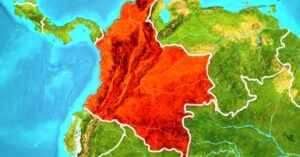How to Become a Digital Nomad: 7 Useful Tips
5 min read
Many of us have seen those digital nomad images of a laptop next to a coconut, a gorgeous ocean in the background and the hashtag #officeoftheday. The thought of working from the beach or a hammock in a tropical location can easily induce envy, especially if you’re sitting in a cubicle or working from home in your sweatpants.
I’ve been a digital nomad for the last three years, so I know a lot about traveling the world while working remotely. I’ve been to 52 countries, made many friends along the way and had amazing experiences as a nomad traveler.
Here are some of the most important things to think about when you’re considering how to become a digital nomad, especially if you’re hoping to travel the world.
What is a digital nomad?
Digital nomads earn a living by working online while living in different locations based on their choosing instead of from a specific work location. Because their job or career is entirely remote, digital nomads can be full-time travelers as long as they have access to Wi-Fi and modern technology needed to do their work.
The ability to live and work from nearly anywhere opens up a world of possibilities to create the lifestyle you desire.
Tips to start your digital nomad life
1. Choose a city with a digital nomad community
Having a community of nomads to connect with is crucial. When you’re thinking about a destination, there’s a lot to consider; if you go to a city that has an established nomad community, you’ll more likely have built-in support.
Medellin, Colombia, Playa Del Carmen, Mexico and Canggu, Bali are three popular digital nomad destinations, but there are many more. Do your research on Google and Reddit, and check which Facebook groups are available for your chosen city. You can get a lot of your destination-related questions answered before you commit to going there.
2. Pick the right bank account and credit cards
Bank account
Some banks in the U.S. charge a fee when you use another bank’s ATM. In turn, the other banks or ATMs may charge fees of their own. If you don’t select your bank wisely, you may be stuck paying two sets of ATM fees every time you withdraw cash.
Save yourself the headache and choose a bank that reimburses ATM fees. Charles Schwab is a popular choice for digital nomad banking because it offers unlimited worldwide ATM fee rebates.
Credit cards
You’ll also want to get a travel credit card that doesn’t charge foreign transaction fees, which can be as high as 3%. There’s no reason to pay these if you don’t have to. Premium travel credit cards waive foreign transaction fees and also offer bonus points on certain categories (e.g., travel, dining, grocery purchases) and various perks for traveling.
3. Decide what to do with your stuff
If you want to be a digital nomad, the easiest scenario is to finish your apartment lease and store your stuff with family or at a storage facility. If your situation is more complicated, that doesn’t mean you’re out of luck.
If you own your house or apartment, consider renting it out to a long-term tenant. Or if your city allows home-sharing, like Airbnb or VRBO, consider hiring someone to manage that process for you. This can be a great way to reduce your overhead costs and potentially make a profit.
4. Choose a location that aligns with your working hours
If you have a U.S.-based remote job (or clients), you’d have the easiest time working from locations that have overlapping time zones with the U.S. Avoid destinations like Asia, where the time difference can easily be 10 to 12 hours, making it very difficult to have any sort of social life or a healthy routine in addition to work.
5. Consider your technology requirements
SIM card (phone)
If you have a phone plan with a U.S. provider, chances are you’ll have to pay a lot for roaming internationally or your data will be capped at a lower speed after you’ve exhausted your free international data allowance.
A common travel hack is to buy a prepaid SIM card with a data plan at your international destination. Store your existing SIM card in a safe place and insert the local SIM card into your phone. This can sometimes be as cheap as around $7 for 4 gigabytes of data, and can include free WhatsApp, social media and, with some plans, local calling.
This is a much better option than constantly keeping your phone on airplane mode and searching for a Wi-Fi network. That’s just not a sustainable solution when you’re living abroad as a digital nomad (as opposed to being a vacationer).
VPN (computer)
If you’re going to live and work abroad, purchase a Virtual Private Network from a reliable provider (there are many). A VPN will make it easier for you to log in to U.S.-based sites, not to mention watch Netflix and other streaming services (which may not be available in the country you’re visiting).
6. Get travel insurance
Depending on where you travel to, local healthcare may be relatively inexpensive compared to coverage in the U.S. However, still consider purchasing travel insurance or travel medical insurance in case you experience an emergency. Most U.S.-based insurance plans do not cover you internationally.
7. Join co-living communities
If you’ve done all the research, but still feel nervous about taking the leap on your own, consider joining a co-living/co-working community. There are several well-known companies that run coordinated gatherings that range in length from one month to one year in various parts of the world.
If you’re interested, you’ll need to submit an application. Usually, they cater to aspiring or existing remote workers and entrepreneurs who want to make friends while living and working abroad.
You can have a real career as a digital nomad
Due to the pandemic, working remotely has become more normalized, shifting the nomad scene into the mainstream. A common misconception of the digital nomad lifestyle is that people who do this are sacrificing financial stability or have shady jobs. That is not the case.
The last year has demonstrated that many of us can work from our laptops without needing to step foot into an office. And there are plenty of remote work job search sites that list a variety of open positions.
If you already have a job you love, consider asking your boss to let you work remotely permanently. You’ll need to have a salient argument and assure the company that your performance won’t suffer. You’ll be well on your way to working remotely while traveling the world.
How to maximize your rewards
You want a travel credit card that prioritizes what’s important to you. Here are our picks for the best travel credit cards of 2023, including those best for:



